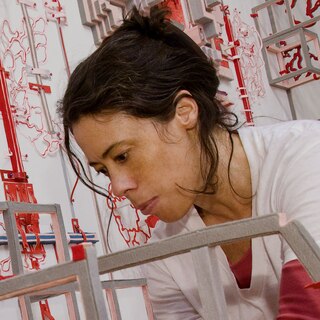
Diana Cooper is an American visual artist, known for largely abstract, improvised hybrid constructions that combine drawing, painting, sculpture, installation and photography. Her art has evolved from canvas works centered on proliferating doodles to sprawling installations of multiplying elements and architectonic structures. Critics have described her earlier work—primarily made with craft supplies such as markers, pens, foamcore, pushpins, felt, pipe cleaners, tape and pompoms—as humble-looking yet labor-intensive, provisional and precarious, and "a high-wire act attempting to balance order and pandemonium." They note parallels to earlier abstract women artists such as Eva Hesse, Lee Bontecou, Elizabeth Murray, and Yayoi Kusama. Lilly Wei, however, identifies an "absurdist playfulness and Orwellian intimations" in Cooper's work that occupy a unique place in contemporary abstraction.

Hannah Wilke (born Arlene Hannah Butter; was an American painter, sculptor, photographer, video artist and performance artist. Her work is known for exploring issues of feminism, sexuality and femininity.

Jane R. Hammond is an American artist who lives and works in New York City. She was influenced by the late composer John Cage. She collaborated with the poet John Ashbery, making 62 paintings based on titles suggested by Ashbery; she also collaborated with the poet Raphael Rubinstein.
Judy Pfaff is an American artist known mainly for installation art and sculptures, though she also produces paintings and prints. Pfaff has received numerous awards for her work, including a John D. and Catherine T. MacArthur Foundation Fellowship in 2004 and grants from the John Simon Guggenheim Memorial Foundation (1983) and the National Endowment for the Arts. Major exhibitions of her work have been held at the University of Wisconsin–Madison, the Denver Art Museum and Saint Louis Art Museum. In 2013 she was elected to the American Academy of Arts and Sciences. Video interviews can be found on Art 21, Miles McEnery Gallery, MoMa, Mount Holyoke College Art Museum and other sources.

Jessica Stockholder is a Canadian-American artist known for site-specific installation works and sculptures that are often described as "paintings in space." She came to prominence in the early 1990s with monumental works that challenged boundaries between artwork and display environment as well as between pictorial and physical experience. Her art often presents a "barrage" of bold colors, textures and everyday objects, incorporating floors, walls and ceilings and sometimes spilling out of exhibition sites. Critics suggest that her work is informed by diverse artistic traditions, including abstract expressionism, color field painting, minimalism and Pop art. Since her early career, they have noted in her work an openness to spontaneity, accident and marginality and a rejection of permanency, monetization and disciplinary conventions that Stephen Westfall characterized as an "almost shocking sense of freedom."
Mel Kendrick is an American visual artist and sculptor known primarily for his abstract, three-dimensional forms derived from sliced and reconstituted wooden blocks. Kendrick's work is understood to reflect a deep fascination with process, space, geometry, and natural forms and materials.
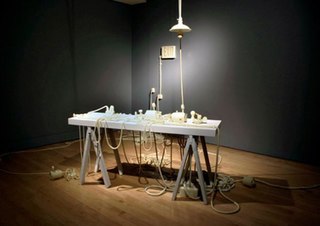
Jeanne Silverthorne is an American sculptor, known for cast-rubber sculptures and installations that explore the artist's studio as a metaphor for artistic practice, the human body and psyche, and mortality. She gained prominence in New York City in the 1990s, as one of several material-focused sculptors who critiqued the austere, male-dominated Minimalist movement by embracing humble, unorthodox media and hand-made, personal and ephemeral qualities championed by artists such as Eva Hesse and Louise Bourgeois. She treats the studio as a physical and conceptual site to be excavated, documented and inventoried, examining in the words of Sculpture's Jan Riley "the end of studio arts … and the impossibility of this mode of expression regaining its former creative validity and vitality in today’s world." Art in America critic Raphael Rubinstein wrote that, like the late studio paintings of Philip Guston, Silverthorne examines "deeply melancholic realms, enlivened by the occasional mordant joke, in which lowly objects are relentlessly and lovingly queried for a meaning they never seem quite ready to yield."

Marjorie Virginia Strider was an American painter, sculptor and performance artist best known for her three-dimensional paintings and site-specific soft sculpture installations.

Joyce Kozloff is an American artist known for her paintings, murals, and public art installations. She was one of the original members of the Pattern and Decoration movement and an early artist in the 1970s feminist art movement, including as a founding member of the Heresies collective.

Nancy Rubins is an American sculptor and installation artist. Her sculptural works are primarily composed of blooming arrangements of large rigid objects such as televisions, small appliances, camping and construction trailers, hot water heaters, mattresses, airplane parts, rowboats, kayaks, canoes, surfboards, and other objects. Works such as Big Edge at CityCenter in Las Vegas contain over 200 boat vessels. Stainless Steel, Aluminum, Monochrome I, Built to Live Anywhere, at Home Here, at the Albright-Knox Art Gallery in Buffalo, contains 66 used aluminum boats and rises to a height of 30 ft.

Nene Humphrey is a New York-based multidisciplinary artist. Her work has been compared to that of Kiki Smith, Janine Antoni, Petah Coyne, and Louise Bourgeois. She has lived and worked in New York since 1978. Humphrey’s work explores the body, loss, the neuroscience of emotion, and the beauty inherent in both. The integration of art and science is fundamental to Humphrey’s art practice, which often takes the form of iterative research-based projects.
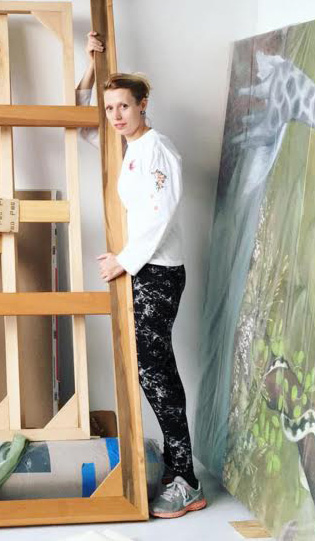
Katerina Lanfranco is a New York City-based visual artist making paintings, drawings, sculptures, and mixed media installations. She was born in Hamilton, Ontario. She studied art at the University of California, Santa Cruz where she received her B.A in Visual Art and in "Visual Theory and Museum Studies". She also attended the Sierra Institute studying Nature Philosophies and Religions while camping in the California wilderness. She received her M.F.A from Hunter College, City University of New York in Studio Art, with an emphasis in painting. In 2004, she studied at the Universitat der Kunst (UdK) in Berlin, Germany on an exchange scholarship. During this time, she also received a travel grant to study Baroque and High Baroque painting in Italy.

Nicole Eisenman is a French-born American artist known for her oil paintings and sculptures. She has been awarded the Guggenheim Fellowship (1996), the Carnegie Prize (2013), and has thrice been included in the Whitney Biennial. On September 29, 2015, she won a MacArthur Fellowship award for "restoring the representation of the human form a cultural significance that had waned during the ascendancy of abstraction in the 20th century."
Mimi Smith is an American visual artist. She is a pioneer in early feminist and conceptual art focusing on clothing sculpture and drawing installation. She lives and works in New York City.

Nade Haley was an American visual artist whose work has been exhibited at numerous museums and galleries, and is held in public and private collections. After relocating from Washington DC, Haley lived and kept studios in New York City and in Cape Breton, Nova Scotia.
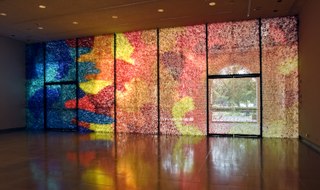
Lisa Hoke is an American visual artist based in New York City and Hudson Valley, New York. She is known for colorful, immersive installations and abstract sculptures characterized by labor-intensive working processes and inventive use of repurposed consumer detritus as raw materials. Her work has often challenged notions of mastery, permanence and fixed meaning, embracing qualities such as contingency and transience. In early sculptures, she tested gravity and balance with intuitively arranged, tenuous suspensions; her later large-scale installations are created on-site and dismantled after exhibition, their materials saved for future re-use. Hoke first gained recognition in the 1990s as one of a number of sculptors that mined the domestic sphere for materials and ideas, in her case, mixing elements of formalism and postminimalism, Pop assemblage, and social, often feminist, commentary. In the 2000s, critics have compared the bright, swirling forms and textures of her installations to the varied surfaces of Antoni Gaudí and the sparkling patterns of Seurat and Klimt.
Caitlin Cherry is an African-American painter, sculptor, and educator.

Elana Herzog is an American installation artist and sculptor based in New York City. She is most known for abstract, tactile works in which she disassembles, reconfigures and embeds second-hand textiles in walls, modular panels and architectural spaces with industrial-grade metal staples. Herzog has been recognized with a Guggenheim Fellowship, Anonymous Was a Woman Award and Louis Comfort Tiffany Foundation Award, among others. She has exhibited nationally and internationally, including at the Brooklyn Museum, Museum of Arts and Design (MAD), Tang Museum, Weatherspoon Art Museum, Sharjah Art Museum, and Reykjavik Art Museum.
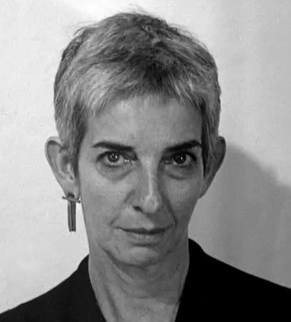
Elke Solomon was an American artist, curator, educator and community worker. She was known for her interdisciplinary practice that combines painting, drawing, object-making, performance and installation. Solomon exhibited widely in the United States and abroad.
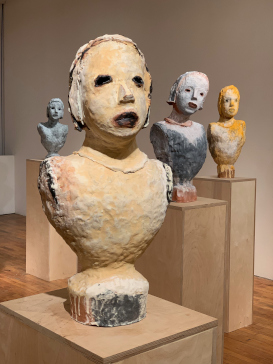
Elise Siegel is an American sculptor and installation artist based in New York City. She is known for several bodies of figurative work that use subtle and ambiguous gesture and facial expression to evoke psychic and emotional states. In the 1990s, she first gained recognition for garment-like constructions that blurred boundaries between clothing, skin and body, critiquing the roles fashion and plastic surgery play in the construction of sexual and cultural identity; writer Mira Schor included Siegel among the cohort of artists she dubbed "Generation 2.5" and credited for developing the tropes of feminist art. After shifting to clay as her primary material, Siegel was one of a number of artists in the 2000s whose work spurred a rebirth in figurative ceramics emphasizing emotional expression, social conditions, identity and narrative. Her ceramic work—which ranges from roughly modeled portrait busts to highly charged, theatrical installations—is said to capture fleeting moments of internal struggle, conflict and vulnerability, creating a psychological tension with the viewer.



















